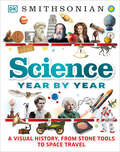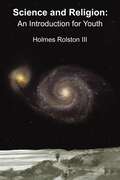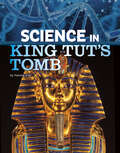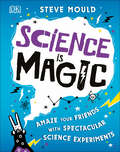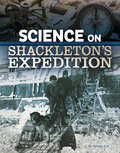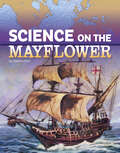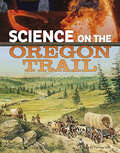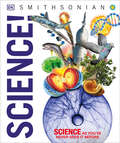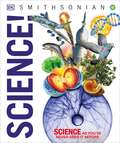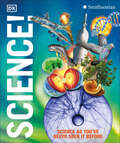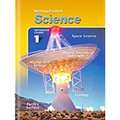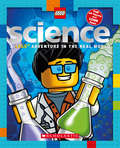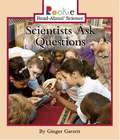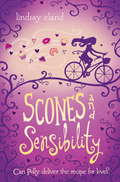- Table View
- List View
Science Voyages: Volume 2 (California Edition)
by Mcgraw HillHow many plants and animals are discovered each year? You might think that the answer would be a small number, or perhaps none at all, but that would not be right. Life scientists discover, describe, and name hundreds of organisms every year. How do they decide if a certain plant belongs to the iris or orchid family of flowering plants? Or, if an insect is more like a grasshopper or a beetle? Think about how scientists might make these distinctions. The science of classifying is called taxonomy (tak SAHN uh mee). Classification is an important part of your life.<P> This text starts with Chapter 21.
Science Workshop: 60 Creative Ideas for Budding Pioneers
by Anna ClaybourneLearn, make and innovate with this bumper book packed with sixty projects. Science Workshop is the go-to guide for creative and unique experiments. With chapters on art, food, nature, pure science and technology, this book will have a great 'make' for you. Step-by-step instructions can help you:-Take to the skies with a plane inspired by the Wright brothers-Light up the world with a neon sign influenced by artist Tracy Emin-Construct a stunt ramp to get to grips with forces like Galileo Galilei-And much, much more! All the projects in Science Workshop are prompted by featured profiles of great scientists, artists and engineers. Learn about and create the experiments and builds that have led to world-changing discoveries, amazing machines and inspiring artworks. Perfect for KS2 science and technology classes aged 9 and up.
Science Year by Year: A Visual History, From Stone Tools to Space Travel (DK Children's Year by Year)
by DKThis epic journey of scientific discovery starts in ancient times and travels through centuries of invention before fast forwarding into the future. From simple machines to modern-day marvels, you&’ll follow incredible illustrated timelines that plot the entire history of science and highlight the most momentous discoveries. A jaw-dropping collection of more than 1,500 photographs, illustrations, maps, and graphics charts the evolution of science year by year, century by century. You&’ll meet influential inventors and famous faces from the past, including Aristotle, Leonardo da Vinci, Isaac Newton, Charles Darwin, Marie Curie, and Stephen Hawking. You&’ll visit places of scientific importance, such as prehistoric cave art, Stonehenge, Hiroshima and the first atomic bomb, the Moon landings, and the Higgs boson particle. These huge events are made simple thanks to eye-catching images, helpful timelines, and accessible, informative text. Landmark people and periods are combined in this one stunning volume for children, showcasing the ideas, experiments, and technologies that have shaped our daily lives and transformed the world today. Aspiring scientists, get ready for a time traveling trip like no other.
Science You Can Eat: 20 Activities that Put Food Under the Microscope
by Stefan GatesDiscover the incredible, edible science that happens every time you cook, bake, or eat with this children's ebook that is part-cookbook, part-science reference.This exciting kids' ebook tackles all the tasty science questions you have about food - plus plenty more that you hadn't even thought of! Science You Can Eat will transform your kitchen into an awesome lab through 20 fun food experiments.This quest of gastronomic wonder is so much more than just another science ebook for kids! It explores the science of food by asking questions you're hungry to know the answers to and putting them to the test through fun experiments.Cooking is just delicious chemistry, and the science experiments in this adorable kids cookbook will prove it. Once you understand science, you understand food. Find out why popcorn goes "pop" as you test it out for yourself. Explore how taste is affected by smell, know if carrots really can turn you orange, and finally discover whether eating insects is the future of food.There is a fantastic mix of fun facts and knowledge, context, and science experiments for kids in this educational ebook. The experiments are easy to execute at home with things you have around the kitchen. The instructions are detailed but easy to understand, so some kids could even adventure solo through its pages.Enjoy the delightful weirdness of tricking your taste buds, making slime taste delicious, investigating some of the strangest flavors around, and extracting iron from your cereal! Science You Can Eat helps your little one understand what's happening with their food and why. Each page is guaranteed to leave you hungry for more - we'd wager even adults will learn a thing or two from this culinary escapade.Explore, Experiment, And Learn!Explore the world of weird, mind-blowing, and often gloriously revolting (but tasty) science behind the food we eat; from why onions make us cry to the sticky science of chewing gum.Packed with activities for kids that allow you to use the power of science in the most delicious way. You'll concoct color-changing potions, make scrumptious ice-cream in an instant, and much, much more.Embark on this incredible edible adventure with TV presenter Stefan Gates AKA &“The Gastronaut&” and turn the things we eat from the ordinary into the extraordinary. Some of food fueled science you'll learn about:- Unusual foods- The world's smelliest fruit- Salt and other marvelous minerals- Ways of cooking- Drinks that glow and so much more!
Science and Religion: An Introduction for Youth
by Holmes Rolston IIIThis is written for young people, grades 9-12, to read on their own, with others their age, as well as with parents and teachers.How is the scientific method similar to and different from the way that Christians think? One tends to see what one is looking for. Those who think about religion also use such frameworks. They may call them creeds. Both science and religion open up "big questions." Scientists seek causes; believers seek meanings.The origin and creation of the universe displays some surprising features. Physicists have found dramatic connections between astronomical and atomic scales that combine to make the Earth and its life possible. The mid-range scales where the most complex things are found depend on the interacting microscopic and astronomical ranges. The universe is "user-friendly."Scientific concepts of the origin of life are very different from the Genesis creation stories. Genetics is about creating, storing, elaborating information. The Genesis stories are a parable that reveals the meaning of creation. Biological science does discover a wonderland Earth. The Genesis parable affirms a land of promise, today an Earth with promise.The human mind is the most complex thing in the known universe. How much science of persons can psychologists have? Neuroscience has discovered remarkably plastic, flexible minds. Resolute behavior, especially in youth, re-shapes our minds. Humans have huge cognitive power gained by speech and language. Jesus teaches us to love God and neighbor. The two great commandments are not the facts of any science.The knowledge and wisdom of past and present transmitted to the future in cultures is as important as what we inherit genetically. How are youth shaped by their rearing, by their peer groups? How do people behave socially in groups: government, politics, churches, economics, and business? Also, evaluating ethical responsibilities for love and justice demands religious and philosophical judgments.Contemporary scientists have added a new science. What of artificial intelligence, of massive computing power? This aids science, makes possible new discoveries. Youth have pages on Facebook. They twitter. How will this behavior affect their adult character? Youth hear a lot about STEM - science, technology, engineering, math. Youth need faith and ethics to evaluate the values in STEM.Natural and cultural histories require searching for meanings. History is more narrative, the stories of personal life that shape history: Abraham, Muhammad, Jesus, Martin Luther, Martin Luther King, Israel, England, America, and the Second World War Youth today will write the history of this first century of the new millennium, with challenges as painful as ever. To do that with justice and love, they need the wisdom of the Christian faith. XX
Science at the Movies
by Rebecca BoyleHave you ever wondered what movie makers do when they want to know what a black hole looks like? Or how high people could jump on mars? In this interview, Mika McKinnon, movie science adviser, shares what it’s like to do research for movies and television.
Science in King Tut’s Tomb (The Science of History)
by Tammy EnzOne of the most well-known pharaohs from ancient Egypt was King Tut. Did you know that science played a big role in acient Egypt? Find out how the Egyptian pyramids were engineered. Learn about the science behind King Tut's mummy. And discover how modern technology helps us learn more about King Tut's life and death.
Science is Lit: Crazy chemistry and epic experiments with TikTok science sensation BIG MANNY
by Big MannyAlright BOOM, Big Manny is here to show you how you can become a real-life scientist and create awesome experiments at home using ordinary ingredients.We'll learn some basic (and not-so basic) chemistry tings - from combustion to chromatography (chroma-what-now?).We'll meet the amazing elements that each have their own personalities - from fiery hydrogen to the main man oxygen.And we'll create explosive reactions - from fizzing mixtures to dish soap volcanoes!Let's start experimenting and find out why science is lit, innit.Written by TikTok science sensation Big Manny, this is the perfect book to inspire young scientists aged 8–12.
Science is Magic: Amaze Your Friends With Spectacular Science Experiments
by Steve MouldPacked with over 40 magical science tricks for kids using simple experiments! Join comedian and author Steve Mould, #1 bestselling author of How to be a Scientist, and learn the secrets behind some of the most famous magic tricks and illusions (and learn some of your own). Learn how to bend water with a balloon, turn water into juice, make a glass beaker disappear in oil, and wow your friends with levitating tinsel! Packed with optical illusions, pranks, and fun facts, this ebook is a must-have for any aspiring scientist or magician (the two aren't as different as you might think)!Each trick is explained using step-by-step photographs, and the science behind each one is showcased clearly and simply. Sprinkled throughout the ebook are profiles of famous magicians and illusionists, such as Harry Houdini and David Blaine, and stories of how they used science to create their most famous tricks.Science is Magic is the perfect addition to any family bookshelf or classroom, putting a fresh spin on science for kids. What's fantastic about this kids&’ activity ebook is that many of the magic tricks or experiments are something you learn to perform on a friend and require practice. Thus, (the genius bit) it&’s not something kids will just do once and then turn the page.Think Magic Is Just An Illusion? Think again! Discover science - REAL magic at your fingertips. Learn some amazing experiments to wow your friends, find out how magicians use science in their most famous tricks, and discover the magic of the world around you. Packed with activities for kids from magic tricks to optical illusions, and peppered with fascinating facts, this educational ebook is a must-have for scientists and magicians alike. Added bonus, each &‘trick&’ or experiment in the ebook uses simple items that can be grabbed from home or a hardware store. Get ready to wow your friends with some cool science-backed magic like:- Magnetic fingers- Reading minds- Color changing potion- Guess the coin- Floating ping pong ball and much more! Add other fun-filled Steve Mould titles in the DK collection to your bookshelves, like How To Be A Scientist and The Bacteria Book.
Science on Shackleton’s Expedition (The Science of History)
by Tammy EnzSir Ernest Henry Shackleton led an expedition across Antarctica in 1914. Did you know that science played a big role in this dangerous journey? Learn how weather patterns affected the explorer in Antarctica. Find out the science behind Shackleton’s ship, The Endurance. And discover how modern technology is being used to find out even more about this adventure more than 100 years later.
Science on the Mayflower (The Science of History)
by Tammy EnzYou may have heard of the Mayflower. The ship set sail in 1620, carrying English pilgrims across the sea to Plymouth. But did you know that science played a big role in this voyage? Learn how the Mayflower was constructed. Find out how science helped sail the ship across the ocean. And discover how modern technology is being used to understand the journey and the people aboard.
Science on the Oregon Trail (The Science of History)
by Tammy EnzYou may have heard of the Oregon Trail. In the 1840s, more than 5,000 people traveled the Oregon Trail, hoping for a better life. But did you know that science played a big role in this epic journey? Learn how covered wagons were engineered. Find out how food was preserved and diseases were treated along the trail. And discover how modern technology is helping us learn even more about this time in history.
Science! (DK Knowledge Encyclopedias)
by DKExplore science as you&’ve never known it before with this children's encyclopedia perfect for budding scientists!Forming part of a fantastic series of kid's educational books, this bold and brilliant kid's encyclopedia uses ground-breaking CGI imagery to reveal the world as you've never seen it before. Informative, diverse in subject matter, easy-to-read and brimming with beautiful graphics, young learners can explore the incredibly detailed cross-sections and cutaways that reveal the scientific inner workings of just about everything!This charming children&’s encyclopedia opens the world in new ways, with: - Packed with facts, charts, timelines, and infographics that cover a vast range of topics. - Encompassing a visual approach with illustrations, photographs and extremely detailed 3D images.- Crystal clear text distills the key information.- DK's encyclopedias are fact-checked by subject experts to offer accuracy beyond online sources of information.This fully-updated edition of Knowledge Encyclopedia Science! is the perfect encyclopedia for children aged 9-12, ideal for inquisitive minds, providing young readers with an engaging introduction to core science topics, demonstrating how all the major scientific principles fit together and using awe-inspiring illustrations to reveal how biology, chemistry and physics is used every day in the world around us. Jam-packed with spectacular scientific facts, including graphics, facts, and data boxes, this science encyclopedia is sure to delight budding young scientists. Explore, Discover And Learn!DK's Knowledge Encyclopedia Science! uncovers the marvels of our world in unprecedented detail and with stunning realism. Encompassing incredible computer-generated images to reveal and explain science as never before, you can spend quality time exploring the world of science with your children, whether it&’s looking inside a cell, pulling apart a Formula 1 racing car, or examining the forces that hold the Universe together, accompanied by impressive visuals to engage their senses. A must-have volume for curious kids with a thirst for knowledge, this enthralling encyclopedia is structured in such a way that your child can read a bit at a time, and feel comfortable to pause and ask questions. Doubling up as the perfect gift for young readers, who are always asking questions about the inner workings of our planet! At DK, we believe in the power of discovery. This thrilling kid&’s encyclopedia is part of the Knowledge Encyclopedia educational series. Celebrate your child&’s curiosity as they complete the collection and discover diverse facts about the world around them. Dive into the deep blue with Knowledge Encyclopedia Ocean! Travel back in time to when dinosaurs roamed the earth with Knowledge Encyclopedia Dinosaur! And hone your knowledge on how the human body works with Knowledge Encyclopedia Human Body! Whatever topic takes their fancy, there&’s an encyclopedia for everyone!
Science! (Knowledge Encyclopedias)
by DkForming part of a fantastic series of kid's educational books, this bold and brilliant kid's encyclopedia uses ground-breaking CGI imagery to reveal the world as you've never seen it before. Informative, diverse in subject matter, easy-to-read and brimming with beautiful graphics, young learners can explore the incredibly detailed cross-sections and cutaways that reveal the scientific inner workings of just about everything!
Science!, 2nd Edition (DK Knowledge Encyclopedias)
by DKDK’s best-selling richly illustrated encyclopedia series explores the wonderful world of science.Learn the ins and outs of science as you’ve never seen it before, through incredibly detailed 3D illustrations, in this encyclopedia for children aged 9+.Knowledge Encyclopedia’s clear explanations, illustrations, photographs, and 3D images will engage children in complex subjects. Learn about hundreds of vehicles that float, fly, or speed across the land, including the record breakers—the fastest, largest, longest, and strangest modes of transportation ever to zoom, sail, or soar.This all-encompassing science encyclopedia for kids offers: An impressive collection of facts, charts, timelines, and illustrations.A visual approach using illustrations, photographs, and extremely detailed 3D CGI images.Clear explanations of physics, chemistry, and biology, as well as space exploration, the latest technology, wonderful wildlife, and our amazing bodies.Children can explore science in a new and exciting way. Learn about groundbreaking topics like looking inside a cell, pulling apart the ever-present electronics in our lives to see how they work, showing how ships stay afloat, and examining the forces that hold the Universe together. This impressively detailed encyclopedia uses awesome illustrations to show biology, chemistry, and physics in the world around us. All the essential information in easy-to-read text with additional fun facts, and brought to life with amazing 3D illustrations that look inside the anatomy of a blue whale, zoom into a molecule of water, and out of the Solar System.More in the seriesKnowledge Encyclopedia Science! is part of DK’s visual and hugely successful Knowledge Encyclopedia series. Complete the collection and dive into the deep with Knowledge Encyclopedia Ocean!, take a trip to the solar system with Knowledge Encyclopedia Space! and travel back to prehistoric times with Knowledge Encyclopedia Dinosaur!
Science, Level 3 (California Edition)
by Marjorie Slavick Frank Robert M. Jones Gerald H. Krockover Mozell P. Lang Joyce C. Mcleod Carol J. Valenta Barry A. Van DemanThe book covers topic like "Living Things Grow and Change", "Animals Grow and Change ", "People Grow and Change", "Exploring Earth's Surface", Earth's Resources, Earth Long Ago, Matter and Motion.
Science, Level 4 (California Edition)
by Marjorie Slavick Frank Robert M. Jones Gerald H. Krockover Mozell P. Lang Joyce C. Mcleod Carol J. Valenta Barry A. Van DemanFind answers to questions like--What Are the Basic Needs of Animals?, How Do Animals' Body Parts Help Them Meet Their Needs?, What Do Plants Need to Live?, How Do Leaves, Stems, and Roots Help Plants Live?, How Do Plants Reproduce?, What Are Ecosystems?, How Does Energy Flow Through an Ecosystem? and much more information on how Earth's surface has changed, how mountains, volcanoes and earthquakes were formed. A very informative book for students studying science.
Science, Level 5 (California Edition)
by Marjorie Slavick Frank Robert M. Jones Gerald H. Krockover Mozell P. Lang Joyce C. Mcleod Carol J. Valenta Barry A. Van DemanFind answers to questions like What Are Cells, and What Do They Do?, How Do Bones, Muscles, and Nerves Work Together?, How Do Scientists Classify Living Things?, What Are the Functions of Roots, Stems, and Leaves?, How Do Plants Make Food? and many more.
Science: Integrated Course 1
by Mcdougal-Littell Publishing StaffIntegrated Science pulls together units from the different categories of science to give you a broad picture of how scientists study nature.
Science: LEGO Nonfiction
by Penelope Arlon<p>Did you know that the blue whale could blow up 1,250 balloons in a single breath? Or that the Earth's core is as hot as the surface of the sun? <p>Including information about almost every scientific topic in the universe, readers will find out everything they ever wanted to know about fascinating animals, electricity, energy, weather, our galaxy, technology of tomorrow, and so much more. They'll even meet real-life scientists and read all about their exciting work. Complete with hundreds of stunning photographs, fun facts, mini comics, and building ideas, LEGO Science is the perfect book for young readers curious about science. Includes a buildable scientist minifigure! <p>This is a fixed-format ebook, which preserves the design and layout of the original print book.</p>
ScienceFusion: Introduction to Science and Technology
by Houghton Mifflin HarcourtScience Fusion Introduction to Science and Technology.
Scientist, Scientist, Who Do You See?
by Chris Ferrie<p>A scientific twist on a beloved children's classic that's sure to delight both parent and child! <p>Scientist, Scientist, Who do you see? I see Marie Curie in her laboratory! <p>The adored children's classic Brown Bear, Brown Bear gets a nerdy makeover in this picture book by the #1 bestselling science author for kids! Young readers will delight at taking a familiar text and poking fun at it all while learning about scientists and how they changed the world. Back matter includes brief biographical information of the featured scientists. This sweet parody is the perfect inspiration for scientists of all ages! <p>Full of scientific rhyming fun, Scientist, Scientist, Who Do You See? features appearances by some of the world's greatest scientists! From Albert Einstein to Marie Curie and Ahmed Zewail, from Charles Darwin to Chien-Shiung Wu and Grace Hopper... and more!</p>
Scientists Ask Questions (Fountas & Pinnell LLI Blue #Level K)
by Ginger GarrettA simple introduction to scientific investigation, describing what it is and giving examples of how scientists use tools and conduct experiments.
Scientists: Inspiring Tales of the World's Brightest Scientific Minds (DK Explorers)
by DKMeet the people who changed the world of science and technology, biology, chemistry and physics!Read the stories of the brainiest people who ever lived and the scientific discoveries they made. Each page illustrates a famous scientist's life and what made their contribution to this fascinating field so important. Scientists is an exciting book perfect for children ages 7-9 years. Inside you will find: • Stories of more than 50 scientists like Isaac Newton, both famous and lesser-known. • Comprehensive coverage of the most important scientific advancements of all time. • Stories of scientists from all over the world specializing in different areas of science. • Information inline with the STEAM and STREAM school curriculums. Introduce children to titans of science!The biggest scientific breakthroughs in history have something in common: super smart people who kept looking for the answers to some of the world&’s most interesting questions! The pages of this science book are filled with the stories of famous scientists like physicists Neil DeGrasse Tyson and Stephen Hawking, biologist Marie Curie, paleontologist Mary Anning, and lesser-known trailblazers like Chika Kuroda, who became Japan's first female Bachelor of Science.Filled with great detail and following a storytelling format, this is a thrilling book that will capture the imagination of young children and encourage them to explore the world of science. Beautiful descriptions of the scientists' lives are brought to life through stunning watercolor illustrations, and fantastic photography highlights the detail of their discoveries.Discover more stories!Follow the stories of some of the greatest people the world has ever known. DK&’s Scientist, Explorers, and Inventors captures the genius of people who have changed history, answered important questions and made our lives easier.
Scones and Sensibility
by Lindsay ElandSeek tirelessly and you shall not find a contemporary heroine of middle-grade literature as refined and romantic as Miss Polly Madassa. Still swooning over the romantic conclusions of Pride & Prejudice and Anne of Green Gables, twelve-year-old Polly decides her purpose in life: helping along lonely hearts in search of love. Polly's only task this summer is to make deliveries for her parents' bakery, leaving ample time for this young cupid to find hearts to mend--beginning with the kite-store owner, Mr. Nightquist, who will pair perfectly with Miss Wiskerton (the unfairly labeled town curmudgeon). Polly's best friend Fran Fisk is in desperate need of a mother ever since hers ran off with a man she met on the Internet; Polly must find a match for Mr. Fisk. And while she's at it, it wouldn't hurt to find Clementine, Polly's teenaged sister, a beau worthy of her (so she can shed that brute, Clint). Polly's plans are in full swing, so she definitely cannot be bothered by the advances of classmate Brad Barker.But maybe Polly should have turned her attention to Miss Austen's Emma next, because she quickly learns the pitfalls of playing matchmaker. How will Polly patch up her own relationships, while ensuring that destined love can take its course?


